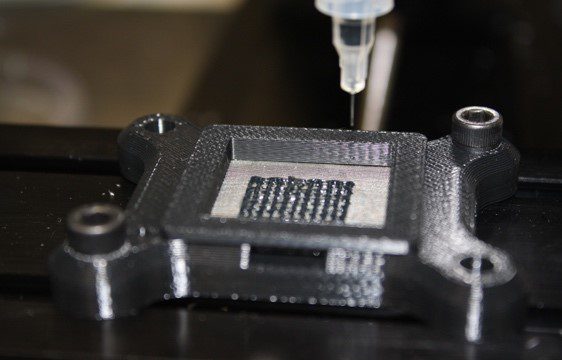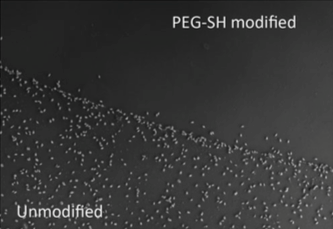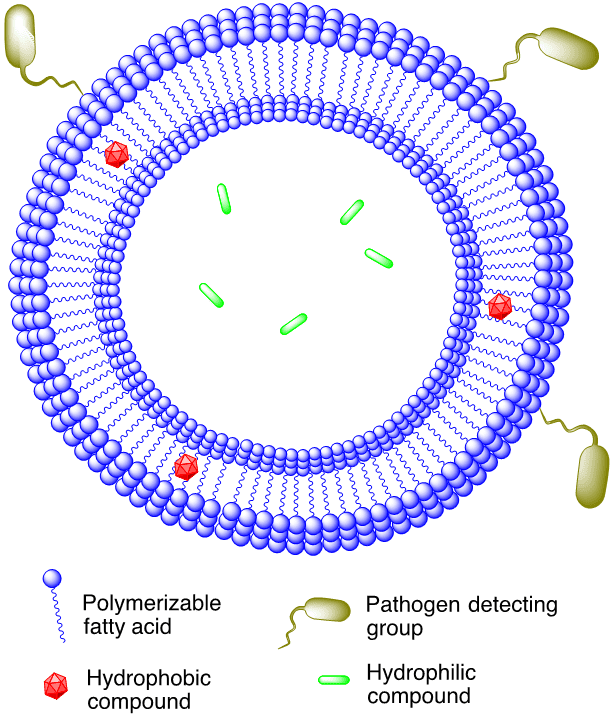
Timothy Hanks
Charles Ezra Daniel Professor and Chair of Chemistry
- Email: tim.hanks@furman.edu
- Phone: 864.294.3373
- Office: Plyler 236B, Townes Science Center
Tim Hanks joined the Chemistry Department at Furman University in 1990. He is currently Charles Ezra Daniel Professor and Chair of Chemistry at Furman and also an Adjunct Professor in the Chemistry Department at Clemson University. He has held positions as a Visiting Professor in the Clemson School of Materials Science and Visiting Scientist at Départment du Recherche Fondamentale sur la Matiére Condensée, Commissariat á l’Energie Atomique in Grenoble, France.
Dr. Hanks is very active in the American Chemical Society (ACS). He holds the Awards Chair and Alternate Councilor positions for the Western Carolinas Section of the ACS, and he is a member of the ACS International Activities Committee. He has organized two Southeast Regional ACS meetings and has twice held the position of Chair of the SERMACS Board of Directors. He is also a recipient of the Ann Nalley Volunteer Services Award for the Southeast Region.
In 2011, Dr. Hanks spent six months as a Fulbright Senior Scholar and Visiting Scientist at the Intelligent Polymer Research Institute at the University of Wollongong, Australia. He is the one of the Directors of Furman’s Research Experiences for Undergraduates Program and actively collaborates with researchers in Australia and Israel. His research group is responsible for more than seventy publications in professional journals and books. In 2017, he was awarded the South Carolina Governor’s Award for Excellence in Scientific Research at an Undergraduate Institution.
Education
- Ph.D., Montana State University
- B.S., South Dakota School of Mines and Technology
Research
The Hanks group is working in two broad areas of soft materials synthesis and characterization, taking inspiration and materials from nature to craft functional structures.1 The first involves the preparation of ionomeric composites composed of polycationic conducting polymers such as polypyrrole or poly(3,4-ethylenedioxythiophene) with biopolymers such as dextran sulfate or alginates. Our long-term goals are to create scaffolds for neural tissue engineering and coatings for nervous system implantable electrodes.

We are using 3D extrusion printers to build cell-infused constructs capable of external electrical stimulation.2 In related work, we have developed a method for modifying the surfaces of electronically conducting polymer films that allows for the control of protein adhesion and the prevention of biofouling. While initially of interest for implant materials, this technology also has wider applications as eco-friendly coatings in marine environments.3, 4, 5

A second area of interest is the assembly of liposomes for use in drug delivery and biosensing. Long chain diacetylene amphiphiles assemble into polymerizable vesicles that are intensely blue in color. Physical stress causes a dramatic color change to a red color and also “turns-on” fluorophores embedded in the bilayer that are quenched in the blue form. Surface derivatization of the structures results in an affinity for bacteria and other species and this interaction can be converted into the stress needed to trigger the sensing system.6, 7, 8 We have recently shown that multiple liposomes, each with a different surface modification and fluorophore, can give a fluorescent “fingerprint” characteristic of a particular pathogen. Polymerization of the vesicles also almost completely stops leakage of species entrapped in the aqueous liposome core. We are developing novel methods to “pop” the liposomes in response to external conditions in order to controllably release drugs or other encapsulants.

1 Introduction to Biomimicry and Bioinspiration in Chemistry Hanks, T. W.; Swiegers, G. F. in "Biomimicry and Bioinspiration in Chemistry" Swiegers, G. F. Ed. Wiley Inc., 2012.
2 Characterization of alginate-polypyrrole composites for tissue engineering scaffolds Wright, C.J.; Zhang, B.; Kuester, M.; Molino, P.J.; Hanks, T.W. Front. Bioeng. Biotechnol. Conference: 10th World Biomaterials Congress. 2016. doi: 10.3389/conf.FBIOE.2016.01.00314.
3 Functionalised Inherently Conducting Polymers as Low Biofouling Materials Zhang, B.; Nagle, A.; Wallace, G.G.; Hanks, T.W.; Molino, P.J. Biofouling 2015, 31, 493-502.
4 Polymers with antifouling properties Australian Provisional Patent, Application Number 2013901089, 2013.
5 Modification of Polypyrrole/Biopolymer Composites for Controlled Cellular Adhesion Molino, P. J.; Zhang, B.; Wallace, G. G.; Hanks, T. W. Biofouling 2013, 29, 1155-1167.
6 Polydiacetylene sensor interaction with food sanitizers and surfactants Zhang, Y.; Northcutt, J.; Hanks, T. W.; Miller, I.; Pennington, W. T.; Jelinek, R.; Han, I. Food Chem. 2017, 221, 515-520.
7 Efficient Production of Fluorescent Polydiacetylene-containing Liposomes for Pathogen Detection and Identification Wright-Walker, C. J.; Hansen, C. E.; Evans, M. A.; Nyers, E. S. Hanks, T. W. MRS Proceed., 2013, 1569, mrss13-1569-qq01-03 doi:10.1557/opl.2013.1099.
8 Polydiacetylene-based Smart Packaging Hill, S. C.; Htet, Y.; Kauffman, J.; Han, I. Y. Dawson, P. L. Pennington, W. T. Hanks, T. W. in Physical Methods in Food Analysis ACS Symp. Ser., Vol. 1138, pp 137-154, Tunick, M. H.; Onwulata, C. I., Eds., American Chemical Society, Washington, DC. 2013.
-
Feinberg, H.; Hanks, Tim. " Polydopamine: a bioinspired adhesive and surface modification platform." Polym Int, 2022, 71,5, 578-582.
-
Peloquin, A.J.; Alapati, S.; McMillen, C.D.; Hanks, T.W.; Pennington, W.T. "Polymorphism, Halogen Bonding, and Chalcogen Bonding in the Diiodine Adducts of 1,3- and 1,4-Dithiane. Molecules." Molecules, 2021, 26, 4985.
-
Zhang, Y., Dawson, P.L., Hanks, T.W., Northcutt, J.K., Tzeng, T.R., Pennington, W.T. "Detecting and correlating bacterial populations to visual color change of polydiacetylene-coated filters", Talanta, 2021, 221, 121482.
-
Siegfried, A.M.; Arman, H.D.; Kobra, K.; Liu, K.; Peloquin, A.J.; McMillen, C.D.; Hanks, T.; Pennington, W.T. "Phosphorus···Iodine Halogen Bonding in Cocrystals of Bis(diphenylphosphino)ethane (dppe) and p-Diiodotetrafluorobenzene (p-F4DIB)" Cryst. Growth Des. 2020, 20, 7460-7469.
-
Wright, C. J., Zhang Molino, B., Chung, J. H. K., Pannell, T., Kuester, M., Molino, P. J., Hanks, T. W. "Synthesis and 3D Printing of Conducting Alginate-Polypyrrole Ionomers", gels, 2020, 6, 13.
-
Zhang, Y., Dawson, P.L., Tzeng, T.R., Hanks, T.W., Northcutt, J.K., Pennington, W.T. "A proposed mechanism to induce multi-layer polydiacetylene-coated filter color response to bacteria", Results Chem., 2020, 2, 100065.
-
Tobias, A.; Rooke, W.; Hanks, T. W. Incorporation of Gold Nanoparticles into the Bilayer of Polydiacetylene Unilamellar Vesicles. Colloid Polym. Sci.,2019,297,85-93.
-
Siegfried, A., McAbee, B., Zotov, V., McMillen, C., Hanks, T. "Dichlorido(2,20′-methylenedipyridine)zinc(II)" IUCrData, 2019, 4, x190131.
-
DiTullio, B. T.; Wright, C. J.; Hayes, P.; Molino, P. J.; Hanks, T. W. Surface modification of polyaniline nanorods with thiol-terminated poly(ethylene oxide). Colloid Polym. Sci., 2018, 296, 637-645
-
Hanks, T. W. Building Soft Nanomachines from Polydiacetylene Liposomes. J. S.C. Acad. Sci., 2018, 16, 1, Article 2.
-
Zhang, Y.; Northcutt, J.; Hanks, T. W.; Miller, I.; Pennington, W. T.; Jelinek, R.; Han, I. Food Chem. 2017, 221, 515-520.
-
Zhang, B.; Nagle, A. R.; Wallace, G. G.; Hanks, T. W.; Molino, P. J. Functionalised Inherently Conducting Polymers as Low Biofouling Materials. Biofouling, 2015, 31 (6), 493-502.
-
Hawthorne, B.; Fan-Hagenstein, H.; Wood, E.; Smith, J. M.; Hanks, T. W. Study of the Halogen Bonding between Pyridine and Perfluoroalkyl Iodide in Solution Phase Using the Combination of FTIR and 19F NMR. Int. J. Spectrosc. 2013, 2013, 1-10.
-
Molino, P. J.; Zhang, B.; Wallace, G. G.; Hanks, T. W. Surface modification of polypyrrole/biopolymer composites for controlled protein and cellular adhesion. Biofouling 2013, 29, 1155-67.
-
Wright-Walker, C.; Hansen, C. E.; Evans, M. A.; Nyers, E. S.; Hanks, T. W. Efficient Production of Fluorescent Polydiacetylene-Containing Liposomes for Pathogen Detection and Identification. MRS Online Proc. Libr. 2013, 1569, 201-206.
-
Hill, S. C.; Htet, Y.; Kauffman, J.; Han, I. Y.; Dawson, P. L.; Pennington, W. T.; Hanks, T. W. Polydiacetylene-Based Smart Packaging. In Physical Methods in Food Analysis; Tunick, M. H., Onwulata, C. I., Eds.; ACS Symposium Series; American Chemical Society: Washington, DC, 2013; Vol. 1138, pp 137-154.
-
Hanks, T. W.; Swiegers, G. F. Introduction: The Concept of Biomimicry and Bioinspiration in Chemistry. In Bioinspiration and Biomimicry in Chemistry; Swiegers, G. F., Ed.; John Wiley & Sons, Inc.: Hoboken, NJ, 2012; pp 1-15.
-
Molino, P. J.; Wallace, G. G.; Hanks, T. W. Hydrophobic conducting polymer films from post deposition thiol exposure. Synth. Met. 2012, 162, 1464-1470.
-
Walsh, R. D. B.; Smith, J. M.; Hanks, T. W.; Pennington, W. T. Computational and Crystallographic Studies of Pseudo-Polyhalides. Cryst. Growth Des. 2012, 12, 2759-2768.
-
Arman, H. D.; Gieseking, R. L.; Hanks, T. W.; Pennington, W. T. Complementary halogen and hydrogen bonding: sulfur- iodine interactions and thioamide ribbons. Chem. Commun. (Cambridge, U. K.) 2010, 46, 1854-6.
-
Kauffman, J. S.; Ellerbrock, B. M.; Stevens, K. A.; Brown, P. J.; Pennington, W. T.; Hanks, T. W. Preparation, characterization, and sensing behavior of polydiacetylene liposomes embedded in alginate fibers. ACS Appl. Mater. Interfaces 2009, 1, 1287-91.
-
West, M. R.; Hanks, T. W.; Watson, R. T. Polydiacetylene-Based Liposomes: An "Optical Tongue" for Bacteria Detection and Identification. J. Chem. Educ. 2009, 86, 373-373.
-
Pennington, W. T.; Hanks, T. W.; Arman, H. D. Halogen Bonding with Dihalogens and Interhalogens. In Halogen Bonding: Fundamentals and Applications ; Springer Berlin Heidelberg, 2008; Vol. 126, pp 65-104.
-
Yuan, Z.; Hanks, T. W. A reversible colorimetric and fluorescent polydiacetylene vesicle sensor platform. Polymer 2008, 49, 5023-5026.
-
Deb, P.; Yuan, Z.; Ramsey, L.; Hanks, T. W. Synthesis and Optical Properties of Chiral Polydiacetylenes. Macromolecules 2007, 40, 3533-3537.
-
Glish, L.; Hanks, T. W. Computational Analysis of Stereospecificity in the Cope Rearrangement. J. Chem. Educ. 2007, 84, 2001-2001.
-
Kauffman, J. S.; Calchera, A.; Behal, S.; Hanks, T. W.; Ellison, M. S.; Pennington, W. T. Polydiacetylenes as probes for monitoring strain in blended films. Abstr. Pap. Am. Chem. Soc. 2006, 231.
-
Hanks, T. W.; Glish, L.; Singh, S.; Johnson, D.; Wright, L. L. Conducting polymers as substrates for surface-mounted molecular devices. Synth. Met. 2005, 153, 177-180.
-
Holmes, B. T.; Deb, P.; Pennington, W. T.; Hanks, T. W. Synthesis and Polymerization Behavior of Tridentate Diacetylene Hosts. J. Polym. Res. 2005, 13, 133-144.
-
Padgett, C. W.; Pennington, W. T.; Hanks, T. W. Conformations and Binding Modes of 2,3,5,6-Tetra(2'-pyridyl)pyrazine. Cryst. Growth Des. 2005, 5, 737-744.
-
Padgett, C. W.; Walsh, R. D. B.; Drake, G. W.; Hanks, T. W.; Pennington, W. T. New Conformations and Binding Modes in Halogen-Bonded and Ionic Complexes of 2,3,5,6-Tetra(2'-pyridyl)pyrazine. Cryst. Growth Des. 2005, 5, 745-753.
-
Hanks, T. W.; Deb, P.; Holmes, B. T.; Pennington, W. T. Design and synthesis of polymerizable tridentate hosts for encapsulation of organoiodides. Abstr. Pap. Am. Chem. Soc. 2004, 227, U431-U432.
-
Hanks, T. W.; Ramsey, L.; Deb, P. Synthesis of Chiral Polydiacetylenes from Amino Acids. In Abstracts of Papers of the American Chemical Society. Division of Polymer Chemistry; Vol. 227, p U436.
-
Hanks, T. W.; Ramsey, L.; Deb, P. Synthesis of Chiral Polydiacetylenes from Amino Acids,. In Abstracts of Papers of the American Chemical Society. Division of Polymer Chemistry; 2004; pp 223-224.
-
Crihfield, A.; Hartwell, J.; Phelps, D.; Walsh, R. D. B.; Harris, J. L.; Payne, J. F.; Pennington, W. T.; Hanks, T. W. Crystal Engineering through Halogen Bonding. 2. Complexes of Diacetylene-Linked Heterocycles with Organic Iodides. Cryst. Growth Des. 2003, 3, 313-320.
-
Gordon, E. R.; Walsh, R. D. B.; Pennington, W. T.; Hanks, T. W. Syntheses and structures of two acridine orange polyiodide salts. J. Chem. Cryst. 2003, 33, 385-390.
-
Holmes, B. T.; Pennington, W. T.; Hanks, T. W. Efficient Synthesis of a Complete Donor/Acceptor bis (Aryl)diyne Family. Synth. Commun. 2003, 33, 2447-2461.
-
Zhang, D.; Klapman, S.; Hanks, T. W. Self-Organization of Gold Nanoparticles on Surface-Modified Conducting Polymer Films. MRS Online Proc. Libr. 2003, 775, P6.38-P6.38.
-
Fu, K.; Huang, W.; Lin, Y.; Zhang, D.; Hanks, T. W.; Rao, A. M.; Sun, Y. Functionalization of Carbon Nanotubes with Bovine Serum Albumin in Homogeneous Aqueous Solution. J. Nanosci. Nanotechnol. 2002, 2, 457-461.
-
Fu, K.; Huang, W.; Lin, Y.; Zhang, D.; Hanks, T. W.; Rao, A. M.; Sun, Y.-P. Carbon Nanotube-Protein Conjugates from Ambient Exchange Reactions. In Proceedings of the Electrochemical Society; 2002; pp 549-562.
-
Hanks, T. W.; Wright, L. L. Techniques in Chemistry: The Centerpiece of a Research-Oriented Curriculum. J. Chem. Educ. 2002, 79, 1127-1127.
-
Holmes, B. T.; Pennington, W. T.; Hanks, T. W. Synthesis of "Acetylene-Expanded" Tridentate Ligands. Molecules 2002, 7, 447-455.
-
Huang, W.; Taylor, S.; Fu, K.; Lin, Y.; Zhang, D.; Hanks, T. W.; Rao, A. M.; Sun, Y. Attaching Proteins to Carbon Nanotubes via Diimide-Activated Amidation. Nano Lett. 2002, 2, 311-314.
-
Zhang, D.; Hanks, T. W. Polypyrrole Surfaces as Substrates for Electroactive Ferrocene-Tethered Assemblies. In Abstracts of Papers of the American Chemical Society. Division of Polymer Chemistry; 2002; pp 376-377.
-
Hanks, T. W.; Bergman, B.; Dillon, P. Design and synthesis of porphyrin-containing arrays on polypyrrole surfaces. Synth. Met. 2001, 121, 1431-1432.
-
Hanks, T. W.; Pennington, W. T.; Bailey, R. D. Iodine and Organoiodide Templates in Supramolecular Synthesis. In Anisotropic Organic Materials; American Chemical Society, 2001; Vol. 798, pp 83-96.
-
Jay, J. I.; Padgett, C. W.; Walsh, R. D. B.; Hanks, T. W.; Pennington, W. T. Noncovalent Interactions in 2-Mercapto-1-methylimidazole Complexes with Organic Iodides. Cryst. Growth Des. 2001, 1, 501-507.
-
Walsh, R. D. B.; Padgett, C. W.; Metrangolo, P.; Resnati, G.; Hanks, T. W.; Pennington, W. T. Crystal Engineering through Halogen Bonding: Complexes of Nitrogen Heterocycles with Organic Iodides. Cryst. Growth Des. 2001, 1, 165-175.
-
Bailey, R. D.; Hook, L. L.; Watson, R. P.; Hanks, T. W.; Pennington, W. T. Tetraiodoethylene: a supramolecular host for Lewis base donors. Cryst. Eng. 2000, 3, 155-171.
-
Bergman, B.; Dillon, P.; Hanks, T. W. Self-Assembly of Chromophoric Arrays on Conducting Polymers. In ANTEC 2000: Society of Plastics Engineers Technical Papers: Orlando, FL, 2000; pp 1463-1467.
-
Bergman, B.; Hanks, T. W. Spectroscopic, Microscopic, and Surface Analysis of Alkanethiol- and Fluoroalkanethiol-Modified Conducting Polymer Thin Films. Macromolecules 2000, 33, 8035-8042.
-
Burke, A.; Dillon, P.; Martin, K.; Hanks, T. W. Catalytic Asymmetric Epoxidation Using a Fructose-Derived Catalyst. J. Chem. Educ. 2000, 77, 271-271.
-
Phelps, D.; Crihfield, A.; Hartwell, J.; Hanks, T. W.; Pennington, W. T.; Bailey, R. D. Synthesis of Polydiacetylene Charge-Transfer Complexes. Mol. Cryst. Liq. Cryst. Sci. Technol. , Sect. A 2000, 354, 523-530.
-
Rimmer, E. L.; Bailey, R. D.; Hanks, T. W.; Pennington, W. T. Complexes of acridine and 9-chloroacridine with I2: formation of unusual I6 chains through charge-transfer interactions involving amphoteric I2. Chemistry 2000, 6, 4071-81.
-
Hanks, T. W.; Mathis, M.; Harsha, W. Synthesis, characterization and polymerization of metal pyrrolyl complexes. Synth. Met. 1999, 102, 1792-1793.
-
Hanks, T. W.; Powell, M.; Wright, L. L. Surface Modification of Conducting Polymer Films. In ANTEC '99: Plastics Bridging the Millennia: 1999; pp 1584-1587.
-
Bailey, R. D.; Hook, L. L.; Powers, A. K.; Hanks, T. W.; Pennington, W. T. Bis(Pyridyl)Cadmium(II) Iodide Complexes: Thermal, Inclusion, and Structural Behavior. Cryst. Eng. 1998, 1, 51-66.
-
Chacko, A. P.; Hardaker, S. S.; Gregory, R. V.; Hanks, T. W. Melting transition in the leucoemeraldine form of polyaniline. Polymer 1998, 39, 3289-3293.
-
Hanks, T. W.; Powell, M.; Gregory, R. V.; Wright, L. L. Surface Modification of Polyaniline Films with 4-Alkyl- and 4-Perfluoroalkylanilines. In Conferences Proceedings at ANTEC '98: Plastics on My Mind: Atlanta, GA, 1998; Vol. 44, pp 1325-1329.
-
Hanks, T. W.; Wright, L. L.; Gregory, R. V. AFM and contact angle studies of surface modified polyaniline thin films. Abstr. Pap. Am. Chem. Soc. 1998, 215, U408-U408.
-
Mathis, M.; Harsha, W.; Hanks, T. W.; Bailey, R. D.; Schimek, G. L.; Pennington, W. T. Synthesis and Characterization of Nickel(II) and Palladium(II) Pyrrolyl Complexes and Their Polymerization to Electroactive Materials. Chem. Mater. 1998, 10, 3568-3575.
-
Mejdrich, A. L.; Hanks, T. W. Structures of (η1-Fluorenyl)Re(Co)5 and (η5-Fluorenyl)Re(Co)3 and Their Thermal Interconversion in Solid Matrices. Synth. React. Inorg. Met. -Org. Chem. 1998, 28, 953-973.
-
Pennington, W. T.; Bailey, R. D.; Holmes, B. T.; Hook, L. L.; Watson, R. P.; Warmoth, M.; Hanks, T. W. Crystal Engineering Through Charge Transfer Interactions. In Transactions of the American Crystallographic Association; Rogers, R., Zaworotko, M., Eds.; American Crystallographic Association, 1998; p 145.
-
Rimmer, E. L.; Bailey, R. D.; Pennington, W. T.; Hanks, T. W. The reaction of iodine with 9-methylacridine: formation of polyiodide salts and a charge-transfer complex. J. Chem. Soc. , Perkin Trans. 2 (1972-1999) 1998, 2557-2562.
-
Bailey, R. D.; Drake, G. W.; Grabarczyk, M.; Hanks, T. W.; Hook, L. L.; Pennington, W. T. Synthesis, structure and thermal decomposition of nitrogen-iodine charge-transfer complexes. J. Chem. Soc., Perkin Trans. 2 (1972-1999) 1997, 2773-2780.
-
Bailey, R. D.; Grabarczyk, M.; Hanks, T. W.; Pennington, W. T. Synthesis, structure and thermal decomposition of tetra(2-pyridyl)pyrazineâ I2 charge-transfer complexes. J. Chem. Soc., Perkin Trans. 2 (1972-1999) 1997, 2781-2786.
-
Chacko, A. P.; Hardaker, S. S.; Gregory, R. V.; Hanks, T. W. Developing High Strength Electrically Conducting Polyaniline Fibers. In Abstracts of Papers of the American Chemical Society. Division of Polymer Chemistry; 1997; pp 367-369.
-
Martin, K.; Hanks, T. W. Soluble Organoiron Derivatives of Polypyrrole. Organometallics 1997, 16, 4857-4860.
-
Powell, M.; Bailey, R. D.; Eagle, C. T.; Schimek, G. L.; Hanks, T. W.; Pennington, W. T. Dicarbonyl(η5-cyclopentadienyl)(pyrrolyl-N)iron(II). Acta Crystallogr. , Sect. C: Cryst. Struct. Commun. 1997, 53, 1611-1613.
-
Steadman, B.; LEE, M.; Hanks, T. W. Modeling the Asymmetric Diels-Alder Reaction: Using a Combination Wet Lab/Computer Lab Approach to Examining Organic Reactions. Chem. Educ. 1996, 1, 1-14.
-
Hanks, T. W.; Hallford, R.; Wright, G. Examining Host-Guest Interactions with an Integrated Spreadsheet/Molecular-Modeling Program. J. Chem. Educ. 1995, 72, 329-329.
-
Kane-Maguire, N.; Hanks, T. W.; Jurs, D. G.; Tollison, R. M.; Heatherington, A. L.; Ritzenthaler, L. M.; McNulty, L. M.; Wilson, H. M. Synthesis, Characterization, and Photobehavior of Δ- and Λfac-Tris((S)-tryptophanato)chromium(III). Inorg. Chem. 1995, 34, 1121-1124.